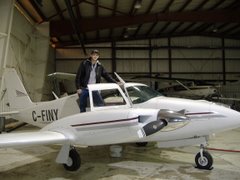I went twin flying again this Friday during my lunch. The weather was a 1600 ft ceiling, and we had some light rain here and there, so we just did circuits. Runway 27 at London is long enough for touch and goes, so that's what we were doing.
The proper procedure for touch and goes is fairly simple, after all three wheels are down, flaps come up, and you go to full power and start your takeoff again, without stopping. I learned a hard lesson about procedures done in the right order. Flying touch and goes in the Cessna 150, the proper procedure is still flaps up, power to full (and then carb heat as well), but since its a slower airplane, with less power, and less travel throttle, you can sometimes get away with going to full power first, and then bringing the flaps up. That's simply because it doesn't take very long to push the power in and a Cessna 150 doesn't accelerate very fast either, so there's plenty of time to do it in either order before the airplane wants to go flying. However in the Comanche, the process of going to full power takes around 4-5 seconds from idle, and the airplane accelerates very rapidly.
Now this landing yesterday I had just touched down with a little bit of power, and while we were rolling along, I decided I'd push the power forward first and get us accelerating first to save us runway and then I'd bring up the flaps. That was my first mistake. As we started to accelerate and my hand was still on the throttle the airplane started to veer back and forth almost uncontrollably left and right. What was happening was what's called wheelbarrowing. That is when the weight comes off the main wheels, or off the ground completely, and shifts to the nose wheel. This can happen in any airplane from the pilot trying to hold it on the ground when the airplane wants to go/stay flying. In the Comanche due to the nosegear being longer then the mains, it can also happen if you try to takeoff with flaps. Normally in the Twin Comanche with no flaps rotation speed is around 90 mph, and the airplane will come off the ground with very little back pressure. So since we had the flaps down, it was trying to come off the ground much slower. It was essentially lifting most of the weight off the main wheels but keeping the nose down, since flying with flaps causes a much more nose down attitude. If I had immediately recognized my mistake I could have given some back pressure, gotten airborne, and we'd have gone flying. Instead I fought to maintain control on the ground because we hadn't reached the Vr (rotation speed) I had in my head. As this was all going on I think I said something like this, "Power to full... whoa... what the heck is happening!? ... flaps up!" My instructor, Richard, answered my question about the same time I did, and he flicked the flaps up for me. At that point we became airborne and everything turned out ok. I turned to Richard after during the climbout and said sheepishly, "That was pretty scary!". He just smiled at me and didn't say anything, aware that I knew where I had gone wrong.
That was a little bit of a lesson the hard way on bad habits. Flying a slow, forgiveable airplane its easy to get into bad habits, like following procedures in the wrong order. A Cessna 150 will let you get away with it, but a faster airplane like the Twin Comanche will bite you. The moral of the story is follow the proper procedures in the right order!
Subscribe to:
Post Comments (Atom)




The beauty of making these mistakes with an instructor is that it does get corrected quickly but it's early in your career and chances are you'll never forget the lesson. Being frightened can leave an indelible impression.
ReplyDelete